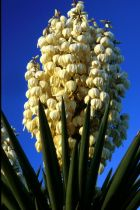Wildflowers of South Texas
...see what is in bloom in South Texas
South Texas literally explodes with color and life during wildflower season. Many of the flowers you will see featured here will be very familiar to you. Learn more about the native flora and see if you can spot them out and about in South Texas.
The pictures are thumbnailed for a faster loading time. Click on the picture of the flower to see a larger photo.
Format notes: Scientific name is in italics or underlined. The Authority is in normal type. Family names are not normally italicized, but some people will put them in a distinctive type (All caps, etc.). The first letter of genera are capitalized. Species epithets are all lower case.
Nipple Cactus

Cactaceae - Cactus Family
Mammillaria gummifera Engelm
Common low growing cactus on various soils in South Texas, with pale pink or creamy petals and red fruit. The needles of the cactus family are actually modified leaves. This special leaf economizes water loss, allowing the cactus flourish in its naturally dry habitat. Feb.-April
Spiderwort
Commelinaceae - Spiderwort Family

Tradescantia hirsutiflora Bush.
Low growing perennial with three petals, occurring in a variety of shades of blue, rose and purple. Feb.-May
Drummond’s Phlox

Polemoniaceae - Phlox Family
Phlox drummondii Hook.
Phlox is common Texas wildflower. Some native populations have red flowers. These red forms are often included in commercial wildflower seed mixtures, though pink is much more common in the wild.
In South Texas, in the deep sands near Sarita, we have a subspecies called Phlox drummondii subsp. glabriflora with trailing or reclining stems instead of the more upright and erect stems of the typical species. Feb.-Jun.
Globe Mallow

Malvaceae - Mallow Family
Sphaeralcea lindheimeri Gray.
The leaves of this species have thick velvety hairs. It is a common plant in deep sands both inland and along the coast. Like its relative Hibiscus, the stamens of the flower are fused into tube surrounding the female parts of the flower. Feb-May (-Dec)
Indian Blanket

Asteraceae - Sunflower Family
Gaillardia pulchella Foug.
An annual or short lived perennial that may flower for a long period of time. Some Indian Blankets may lack the ray florets. Feb.-Dec. Like all members of the Sunflower Family, the Flower is actually a collection of many tiny flowers or florets.
What looks like petals are florets with three of the corolla lobes fused into a single large petal or ray. They are called RAY FLORETS . The florets in the center have five tiny corolla lobes and are called DISK FLORETS.
Meadow Pink, Texas Star

Gentianaceae - Gentian Family
Sabatia campestris Nutt.
Annual with deep rose-pink flowers in damp sandy soils. A smaller flowered species Sabatia arenicola Greenm. Saltmarsh Pink occurs on the islands and the coast. Feb-June.
Blue Curls

Hydrophyllaceae - Waterleaf Family
Phacelia patulaeflora Engelm. & Gray
This small but attractive blue wildflower is found on sandy soils. As its common name suggests, the flower stalk uncurls as the flowers open. Mar.-Nov.
Lantana, Calico Bush

Verbenaceae - Verbena Family
Lantana horrida H.B.K.
This is the native Lantana, with a head of small flowers which open yellow and turn to orange and then red. The plant is a weak shrub and often is seen with its branches supported by other shrubbery.
The foliage has a strong somewhat unpleasant odor when crushed or bruised. Feb.-Dec. The foliage has a strong somewhat unpleasant odor when crushed or bruised. Feb.-Dec.
Lantana

Verbenaceae - Verbena Family
Lantana camara L.
The Lantana with pastel cream to yellow to pink and lavender flowerheads, Lantana camara is not native to Texas. It was a garden plant originally from the West Indies. The black berries it produces are eaten by birds and other wildlife who deposit the seeds in their droppings. It is now naturalized throughout most of Texas. Feb-Dec.
Spanish Dagger, Yucca

Agavaceae - Agave Family
Yucca treculeana Carr.
This dramatic plant may be as much as 5 meters(16 ft) tall in bloom. The flowers are eaten in some parts of Latin America as a seasonal treat. Yuccas are pollinated by a moth that carries pollen from one plant to another and actually stuffs a ball of pollen down the stigma of the flower. She then lays her eggs in the ovary of the same flower. This deliberate pollination insures that her offspring will have seeds to feed on in the developing fruit. Jan.-April
Prickly Poppy

Papaveraceae - Poppy Family
Argemone sanguinea Greene.
As the common name reflects this plants gray green foliage and stems are covered in prickles. While white is the most common, lavender and purple petal forms are also present in South Texas and may be found intermixed.
A yellow flowered species Argemone mexicana L., which is native to the West Indies is also seen sometimes in South Texas. The yellow latex that oozes from cut or broken leaves and stems may irritate the skin of sensitive individuals (though the prickles probably would have gotten you already!) Feb.-Jun. (-Dec)
These images are copyrighted to the Texas A&M University-Kingsville Herbarium.
Special thanks go to Dr. Glenn Perrigo for his gracious donation of these images.
